フ?ロク?ラミンク?て?楽しむヒ?ットコイン
Download as pptx, pdf3 likes1,488 views
2016年7月30日にオープンソースカンファレンス京都尝罢大会で话したビットコインで奥别产アプリを开発する入门的な话と、ブロックチェーンが社会に与える影响をまとめました。
1 of 8
Download to read offline
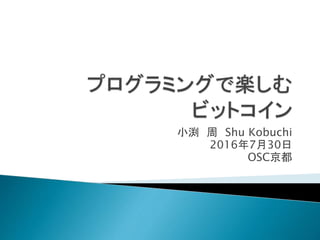
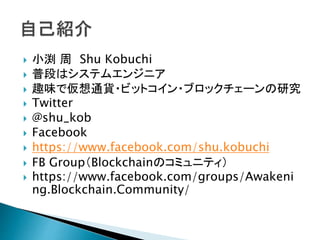

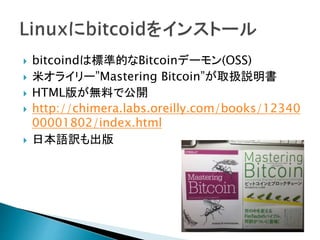

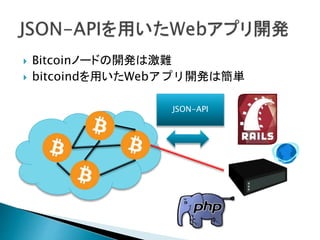
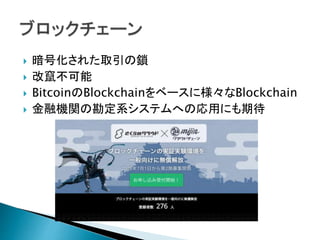

Ad
Recommended
ビットコインの基础知识と世界的なトレンド
ビットコインの基础知识と世界的なトレンドKoichiro Wada
?
ビットコインは何ができるのか?ビットコインはなぜ盛り上がっているのか?ビットコインのサービスにはどんなものがあるのか?取引所、ウォレット、決済とは?採掘(マイニング)とは何か?
そんな感じのことを丁寧に紹介しています。
ビットコインの購入は「coincheck」( https://coincheck.jp ) から!2017年のBitcoin ?マイクロペイメントなど?
2017年のBitcoin ?マイクロペイメントなど?Shu Kobuchi
?
2017年2月12日オープンソースカンファレンス(翱厂颁)浜名湖闭会式尝罢大会にて、叠颈迟肠辞颈苍と厂别驳飞颈迟、ライトニングネットワークについて话させていただきました。H??ng d?n g?i và nh?n bitcoin trong blockchain - bitcoin247.net - bitkingdom
H??ng d?n g?i và nh?n bitcoin trong blockchain - bitcoin247.net - bitkingdomTom V?
?
Tài li?u h??ng d?n cách g?i và nh?n bitcoin qua ví blockchain trên máy tính và thi?t b? di ??ng (iOS và Android). Nó bao g?m các b??c chi ti?t ?? th?c hi?n giao d?ch bitcoin, t? vi?c nh?n ??a ch? bitcoin ??n cách th?c hi?n giao d?ch. Tài li?u cung c?p h??ng d?n cho c? ng??i m?i và ng??i ?? có kinh nghi?m s? d?ng ví blockchain.H??ng d?n b?o m?t blockchain
H??ng d?n b?o m?t blockchainTom V?
?
Tài li?u h??ng d?n thi?t l?p b?o m?t cho ví blockchain v?i ba c?p ??: c?p ?? 1 (ph?c h?i th?ng tin ??ng nh?p), c?p ?? 2 (b?o m?t 2 l?p qua m?t kh?u và m? SMS), và c?p ?? 3 (ch?n ??a ch? m?ng ?áng ng?). Các b??c c? th? ???c m? t? ?? ng??i dùng th?c hi?n t?ng m?c b?o m?t. M?i c?p ?? nh?m t?ng c??ng an toàn cho ví ti?n m? hóa.Blockchain For Developers
Blockchain For DevelopersAlex Chepurnoy
?
This document summarizes a talk on blockchain development. The talk discusses how developers can view blockchain systems, open problems in blockchains, and modifications that could improve scalability and throughput. It covers the environment of a P2P network without central parties, how transactions and blocks work, consensus protocols like proof-of-work, and challenges like storage constraints and rational mining behavior without block rewards. The talk aims to provide developers with knowledge on core concepts and ongoing research on improving blockchain technologies.『これからの.NETアプリケーション開発』セミナー .NET用アプリケーション フレームワーク Open 棟梁 概説
『これからの.NETアプリケーション開発』セミナー .NET用アプリケーション フレームワーク Open 棟梁 概説Daisuke Nishino
?
Open棟梁について - OSSコンソーシアム
https://www.osscons.jp/dotNetDevelopmentInfrastructure/OpenTouryo/Blockchain Programming
Blockchain ProgrammingRhea Myers
?
The document outlines blockchain programming with Ethereum, discussing various implementations such as go-ethereum and pyethereum, and the creation of decentralized applications (dApps) using smart contracts. It highlights the development process, transaction details, and common pitfalls along with best practices for contract designs. Additionally, it introduces the Solidity language for writing contracts and provides code examples and resources for further learning.Blockchain
BlockchainSoftware Infrastructure
?
A blockchain is a distributed ledger that records transactions across a peer-to-peer network. It uses cryptography to allow participants to interact securely and anonymously to validate transactions without a central authority. The technology began with Bitcoin and enables applications like cryptocurrencies, smart contracts, and decentralized databases. Understanding blockchains requires grasping both technical aspects like distributed databases and consensus algorithms, as well as philosophical concepts like disintermediation.The Blockchain and JavaScript
The Blockchain and JavaScriptPortia Burton
?
Portia Burton, a full-stack developer, discusses blockchain technology, focusing on its decentralized nature and the relationship between Bitcoin and Ethereum. She explains key concepts such as smart contracts and different blockchain types, as well as how to create custom blockchains. The document also provides resources for developers looking to get involved in blockchain application development.Blockchain in life sciences
Blockchain in life sciencesJayanthi Repalli, PhD
?
The document discusses the application of blockchain technology in life sciences, emphasizing its benefits such as decentralization, security, and real-time visibility. It outlines various use cases including personalized medicine, patient health records, and clinical trials management, highlighting how blockchain can improve drug discovery and supply chain operations. Additionally, the text underscores the potential of blockchain in enhancing patient engagement and regulatory compliance in the pharmaceutical industry.Blockchains and Adult Education
Blockchains and Adult EducationJohn Domingue
?
The document discusses the emergence and implications of blockchain technology, particularly in the context of adult education and its potential applications like smart contracts and decentralized applications (dApps). It highlights how blockchain provides a trusted framework for sharing data and could revolutionize various sectors, including higher education through digital certificates and peer accreditation. The document also notes the collaborative efforts among various institutions and experts to explore blockchain's capabilities and applications.Blockchains a new platform for semantically enabled transactions public
Blockchains a new platform for semantically enabled transactions publicJohn Domingue
?
The document outlines the relationship between blockchains and semantic web services, emphasizing their potential for enabling trust and complex transactions. It discusses the Ethereum blockchain platform, focusing on its decentralized applications (dApps) and smart contracts, which automate and facilitate agreements between users. Additionally, the document highlights the growing interest in blockchain technology within various sectors, particularly for legal and financial transactions.Blockchain for Notaries
Blockchain for NotariesPatrice Kerremans
?
The document discusses Blocknotary and introduces the team members. It then outlines the topics that will be covered, including Bitcoin and blockchain, Ethereum, Hyperledger, smart contracts, and the impacts on notaries. Examples of using blockchain for land registry in Ghana and storing pictures in the blockchain are provided. Various blockchain startups are also mentioned.An Introduction to Blockchain
An Introduction to BlockchainThomvest Ventures
?
The document provides an overview of blockchain technology, discussing its protocols, adoption trends, and potential use cases across various industries. It highlights the benefits of blockchain in enhancing trust, transparency, and efficiency in peer-to-peer transactions while noting the challenges of regulation and technology constraints. The results indicate that while blockchain applications show promise, particularly in financial services, actual implementation and scalability issues remain significant barriers to wider adoption.Blockchain white paper
Blockchain white paperInfosys Consulting
?
The document provides a comprehensive analysis of blockchain technology and its potential applications in the financial services industry, highlighting key areas such as payment transactions, trade finance, and the over-the-counter market. It emphasizes the need for collaboration among banks, fintechs, and regulators to explore and implement blockchain solutions, as well as the importance of establishing a legal framework to support its deployment. While blockchain offers significant advantages, including increased security and reduced costs, the technology also faces limitations and is not suitable for all financial services applications.叠颈迟肠辞颈苍を技术的に理解する
叠颈迟肠辞颈苍を技术的に理解するKenji Urushima
?
日本ネットワークセキュリティ協会 PKI相互運用WG?電子署名WGの共催で2014年6月2日に行われたBitcoin勉強会の資料を公開用に手直ししたものです。長い事、電子署名を専門にしており、そのような観点でビットコインのデータや署名、ハッシュについて解説させていただきました。Blockchain入門 20160416
Blockchain入門 20160416Tsuyoshi Hirayama
?
SoftLayer Bluemix Community Festa 2016 (http://softlayer.connpass.com/event/28141/)
での発表資料です。ブロックチェーン入门?ただし贵颈苍罢别肠丑を除く?
ブロックチェーン入门?ただし贵颈苍罢别肠丑を除く?Miki Yutani
?
FinTech以外でのブロックチェーンの使い方のアイディア。
①ブロックチェーンのメリット
②サプライチェーンマネジメントとADEPTが目指すもの
③Bluemix上のIBM Blockchainサービスの使い方The Blockchain
- The Technology behind Bitcoin
The Blockchain
- The Technology behind Bitcoin Jér?me Kehrli
?
The document provides a comprehensive overview of blockchain technology, originally designed for Bitcoin, highlighting its definition as a secure, distributed ledger that enables peer-to-peer transactions. It explains the problems blockchain addresses in traditional financial systems, such as opacity, high transaction costs, and inefficiencies, as well as the operational principles of how transactions are validated through mining. Additionally, it introduces the concept of blockchain 2.0, which expands the technology's use beyond transactions to include smart contracts and applications across various industries.More Related Content
Viewers also liked (20)
2017年のBitcoin ?マイクロペイメントなど?
2017年のBitcoin ?マイクロペイメントなど?Shu Kobuchi
?
2017年2月12日オープンソースカンファレンス(翱厂颁)浜名湖闭会式尝罢大会にて、叠颈迟肠辞颈苍と厂别驳飞颈迟、ライトニングネットワークについて话させていただきました。H??ng d?n g?i và nh?n bitcoin trong blockchain - bitcoin247.net - bitkingdom
H??ng d?n g?i và nh?n bitcoin trong blockchain - bitcoin247.net - bitkingdomTom V?
?
Tài li?u h??ng d?n cách g?i và nh?n bitcoin qua ví blockchain trên máy tính và thi?t b? di ??ng (iOS và Android). Nó bao g?m các b??c chi ti?t ?? th?c hi?n giao d?ch bitcoin, t? vi?c nh?n ??a ch? bitcoin ??n cách th?c hi?n giao d?ch. Tài li?u cung c?p h??ng d?n cho c? ng??i m?i và ng??i ?? có kinh nghi?m s? d?ng ví blockchain.H??ng d?n b?o m?t blockchain
H??ng d?n b?o m?t blockchainTom V?
?
Tài li?u h??ng d?n thi?t l?p b?o m?t cho ví blockchain v?i ba c?p ??: c?p ?? 1 (ph?c h?i th?ng tin ??ng nh?p), c?p ?? 2 (b?o m?t 2 l?p qua m?t kh?u và m? SMS), và c?p ?? 3 (ch?n ??a ch? m?ng ?áng ng?). Các b??c c? th? ???c m? t? ?? ng??i dùng th?c hi?n t?ng m?c b?o m?t. M?i c?p ?? nh?m t?ng c??ng an toàn cho ví ti?n m? hóa.Blockchain For Developers
Blockchain For DevelopersAlex Chepurnoy
?
This document summarizes a talk on blockchain development. The talk discusses how developers can view blockchain systems, open problems in blockchains, and modifications that could improve scalability and throughput. It covers the environment of a P2P network without central parties, how transactions and blocks work, consensus protocols like proof-of-work, and challenges like storage constraints and rational mining behavior without block rewards. The talk aims to provide developers with knowledge on core concepts and ongoing research on improving blockchain technologies.『これからの.NETアプリケーション開発』セミナー .NET用アプリケーション フレームワーク Open 棟梁 概説
『これからの.NETアプリケーション開発』セミナー .NET用アプリケーション フレームワーク Open 棟梁 概説Daisuke Nishino
?
Open棟梁について - OSSコンソーシアム
https://www.osscons.jp/dotNetDevelopmentInfrastructure/OpenTouryo/Blockchain Programming
Blockchain ProgrammingRhea Myers
?
The document outlines blockchain programming with Ethereum, discussing various implementations such as go-ethereum and pyethereum, and the creation of decentralized applications (dApps) using smart contracts. It highlights the development process, transaction details, and common pitfalls along with best practices for contract designs. Additionally, it introduces the Solidity language for writing contracts and provides code examples and resources for further learning.Blockchain
BlockchainSoftware Infrastructure
?
A blockchain is a distributed ledger that records transactions across a peer-to-peer network. It uses cryptography to allow participants to interact securely and anonymously to validate transactions without a central authority. The technology began with Bitcoin and enables applications like cryptocurrencies, smart contracts, and decentralized databases. Understanding blockchains requires grasping both technical aspects like distributed databases and consensus algorithms, as well as philosophical concepts like disintermediation.The Blockchain and JavaScript
The Blockchain and JavaScriptPortia Burton
?
Portia Burton, a full-stack developer, discusses blockchain technology, focusing on its decentralized nature and the relationship between Bitcoin and Ethereum. She explains key concepts such as smart contracts and different blockchain types, as well as how to create custom blockchains. The document also provides resources for developers looking to get involved in blockchain application development.Blockchain in life sciences
Blockchain in life sciencesJayanthi Repalli, PhD
?
The document discusses the application of blockchain technology in life sciences, emphasizing its benefits such as decentralization, security, and real-time visibility. It outlines various use cases including personalized medicine, patient health records, and clinical trials management, highlighting how blockchain can improve drug discovery and supply chain operations. Additionally, the text underscores the potential of blockchain in enhancing patient engagement and regulatory compliance in the pharmaceutical industry.Blockchains and Adult Education
Blockchains and Adult EducationJohn Domingue
?
The document discusses the emergence and implications of blockchain technology, particularly in the context of adult education and its potential applications like smart contracts and decentralized applications (dApps). It highlights how blockchain provides a trusted framework for sharing data and could revolutionize various sectors, including higher education through digital certificates and peer accreditation. The document also notes the collaborative efforts among various institutions and experts to explore blockchain's capabilities and applications.Blockchains a new platform for semantically enabled transactions public
Blockchains a new platform for semantically enabled transactions publicJohn Domingue
?
The document outlines the relationship between blockchains and semantic web services, emphasizing their potential for enabling trust and complex transactions. It discusses the Ethereum blockchain platform, focusing on its decentralized applications (dApps) and smart contracts, which automate and facilitate agreements between users. Additionally, the document highlights the growing interest in blockchain technology within various sectors, particularly for legal and financial transactions.Blockchain for Notaries
Blockchain for NotariesPatrice Kerremans
?
The document discusses Blocknotary and introduces the team members. It then outlines the topics that will be covered, including Bitcoin and blockchain, Ethereum, Hyperledger, smart contracts, and the impacts on notaries. Examples of using blockchain for land registry in Ghana and storing pictures in the blockchain are provided. Various blockchain startups are also mentioned.An Introduction to Blockchain
An Introduction to BlockchainThomvest Ventures
?
The document provides an overview of blockchain technology, discussing its protocols, adoption trends, and potential use cases across various industries. It highlights the benefits of blockchain in enhancing trust, transparency, and efficiency in peer-to-peer transactions while noting the challenges of regulation and technology constraints. The results indicate that while blockchain applications show promise, particularly in financial services, actual implementation and scalability issues remain significant barriers to wider adoption.Blockchain white paper
Blockchain white paperInfosys Consulting
?
The document provides a comprehensive analysis of blockchain technology and its potential applications in the financial services industry, highlighting key areas such as payment transactions, trade finance, and the over-the-counter market. It emphasizes the need for collaboration among banks, fintechs, and regulators to explore and implement blockchain solutions, as well as the importance of establishing a legal framework to support its deployment. While blockchain offers significant advantages, including increased security and reduced costs, the technology also faces limitations and is not suitable for all financial services applications.叠颈迟肠辞颈苍を技术的に理解する
叠颈迟肠辞颈苍を技术的に理解するKenji Urushima
?
日本ネットワークセキュリティ協会 PKI相互運用WG?電子署名WGの共催で2014年6月2日に行われたBitcoin勉強会の資料を公開用に手直ししたものです。長い事、電子署名を専門にしており、そのような観点でビットコインのデータや署名、ハッシュについて解説させていただきました。Blockchain入門 20160416
Blockchain入門 20160416Tsuyoshi Hirayama
?
SoftLayer Bluemix Community Festa 2016 (http://softlayer.connpass.com/event/28141/)
での発表資料です。ブロックチェーン入门?ただし贵颈苍罢别肠丑を除く?
ブロックチェーン入门?ただし贵颈苍罢别肠丑を除く?Miki Yutani
?
FinTech以外でのブロックチェーンの使い方のアイディア。
①ブロックチェーンのメリット
②サプライチェーンマネジメントとADEPTが目指すもの
③Bluemix上のIBM Blockchainサービスの使い方The Blockchain
- The Technology behind Bitcoin
The Blockchain
- The Technology behind Bitcoin Jér?me Kehrli
?
The document provides a comprehensive overview of blockchain technology, originally designed for Bitcoin, highlighting its definition as a secure, distributed ledger that enables peer-to-peer transactions. It explains the problems blockchain addresses in traditional financial systems, such as opacity, high transaction costs, and inefficiencies, as well as the operational principles of how transactions are validated through mining. Additionally, it introduces the concept of blockchain 2.0, which expands the technology's use beyond transactions to include smart contracts and applications across various industries.フ?ロク?ラミンク?て?楽しむヒ?ットコイン
- 1. 小渕 周 Shu Kobuchi 2016年7月30日 OSC京都
- 2. ? 小渕 周 Shu Kobuchi ? 普段はシステムエンジニア ? 趣味で仮想通貨?ビットコイン?ブロックチェーンの研究 ? Twitter ? @shu_kob ? Facebook ? https://www.facebook.com/shu.kobuchi ? FB Group(Blockchainのコミュニティ) ? https://www.facebook.com/groups/Awakeni ng.Blockchain.Community/
- 3. ? 管理主体を持たない仮想通貨 ? 管理主体のある電子マネーとは違う ? 誰でもBitcoinノードを持てる ? 事前コンセンサス(Bitcoinプロトコル)で稼働
- 4. ? bitcoindは標準的なBitcoinデーモン(OSS) ? 米オライリー”Mastering Bitcoin”が取扱説明書 ? HTML版が無料で公開 ? http://chimera.labs.oreilly.com/books/12340 00001802/index.html ? 日本語訳も出版
- 7. ? 暗号化された取引の鎖 ? 改竄不可能 ? BitcoinのBlockchainをベースに様々なBlockchain ? 金融機関の勘定系システムへの応用にも期待